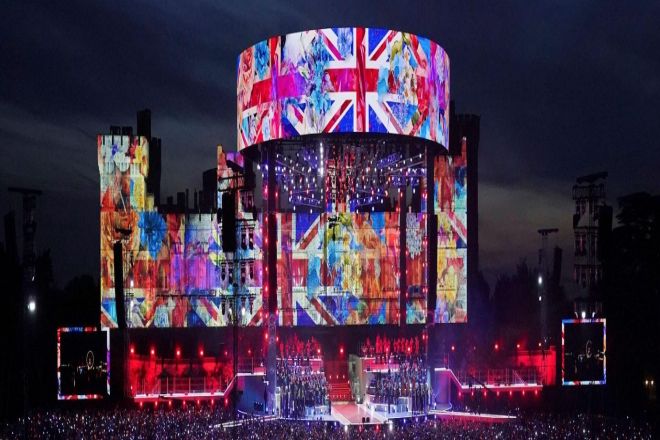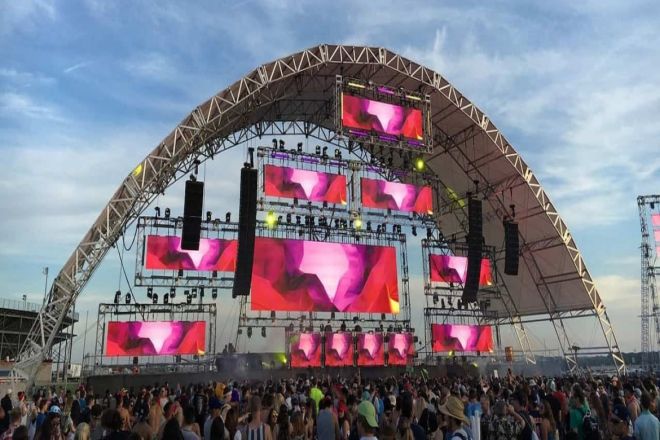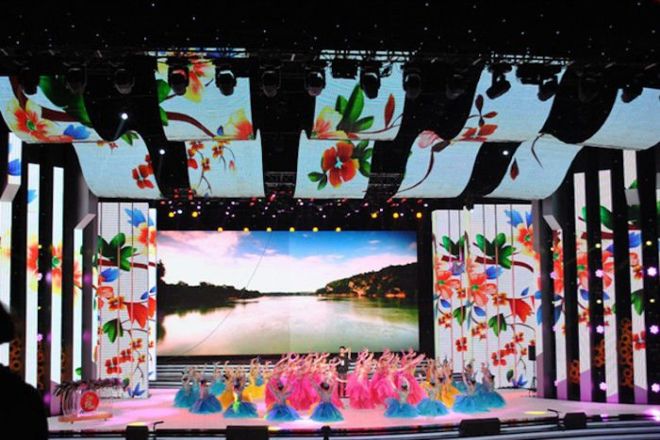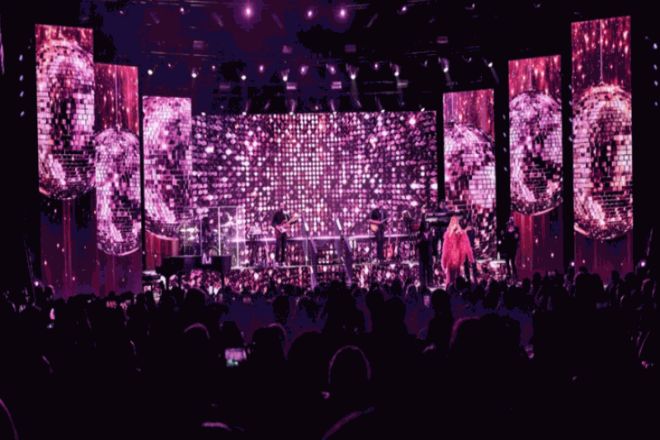Introduction

When you step into the concert, have those dazzling LED display screens ever made you instantly immersed in the ocean of light and music?
They are not only the background of the organiser but also the guide that leads you through the dream. But are you curious about what professional and meticulous requirements are hidden behind these amazing visual effects?
This article will take you to explore the secrets of Écrans d'affichage LED in concerts and directly hit the key elements that shape the visual feast.
From the precise calculation of size layout to the ultimate pursuit of picture quality and brightness, from the solid guarantee of safety and stability to the technological charm of control linkage, we will reveal them to you one by one.
1. Basic construction of LED display screen
1). Tailor-made
At the beginning of the preparation for the concert, the tailor-made LED display screen became an important link that cannot be ignored.
According to the specific size and shape of the performance venue and the distribution of the audience seats, the technical team will conduct detailed measurements and analysis to accurately calculate the size and number of LED display screens required.
This process is not only related to the maximum presentation of visual effects but also directly related to whether the audience can get the best viewing experience.
Through customization, each LED display can be perfectly integrated into the stage environment, adding a touch of bright color to the concert.
2). Visual balance
After determining the size and number of LED displays, the next challenge is how to achieve harmony and balance of stage vision through layout design.
This requires designers to have a keen aesthetic eye and profound artistic accomplishment and to fully consider the overall style of the stage, the content of the performance, and the visual habits of the audience so as to formulate a scientific and reasonable layout plan.
Through clever layout design, not only can visual blind spots be avoided so that every audience can clearly see every detail on the stage, but also a layered and dynamic visual effect can be created, making the audience seem to be in a world full of fantasy colors.
2. Picture quality presentation of LED display

1). The importance of résolution
In the picture quality presentation of LED display, resolution is undoubtedly one of the most important factors. High resolution means higher pixel density, which can delicately restore every detail in the image, making the picture clearer and more realistic.
When the high-definition LED display screen at the concert site shows the stage scene with amazing resolution, the audience seems to be brought into a whole new world, where every subtle expression and every instant change of light and shadow can be seen.
This immersive feeling is the unique charm brought by high resolution.
2). Color authenticity
In addition to resolution, color management is also an indispensable part of the image quality presentation of LED display screens. The importance of color management lies in ensuring that the display screen can accurately and vividly present the color of the original image.
In concerts, the use of colors can often create a specific atmosphere and emotion, and LED displays need to be accurately calibrated and adjusted to ensure that these colors can be accurately conveyed to the audience.
When the audience sees the bright and layered colors on the stage, their hearts will be deeply touched and resonate strongly with the content of the performance.
3). On-site experience: intuitive feeling, atmosphere creation
Finally, we have to mention the audience’s intuitive feeling in front of the high-definition LED display screen.
When the audience is at the concert, facing the huge high-definition LED display, they can not only clearly see every detail and color change on the stage but also feel the shock and impact brought by the improved picture quality.
This intuitive feeling not only allows the audience to participate in the performance more devotedly but also greatly enhances the atmosphere and appeal of the performance.
With the help of a high-definition LED display, the concert scene has become a sea of vitality and passion, and every note and every picture has become an unforgettable memory in the hearts of the audience.
3. Brightness and adaptability of LED display
1). Accurate grasp of luminosité exigences
On the stage of the concert, whether indoors or outdoors, LED display screens need to face complex and changeable lighting conditions. In order to ensure that the screen content can be clearly seen under any circumstances, accurate control of brightness is particularly important.
In indoor environments, the brightness of the display screen needs to be adjusted according to the lighting intensity of the venue and the brightness distribution of the audience seats to avoid visual discomfort caused by too bright or too dark.
In outdoor environments, direct sunlight is a great test for the brightness of the display screen. At this time, high-brightness LED displays have become a must-have. They can penetrate strong light and ensure that the audience can clearly see every detail on the stage, even in direct sunlight.
2). Outdoor challenges: comprehensive protection against waterproofing, dust, and heat dissipation
For outdoor concerts, LED displays not only need to cope with complex lighting conditions but also need to have strong waterproofing, dust, and heat dissipation capabilities. The outdoor environment is changeable, and sudden rain or dust may damage the display.
Therefore, waterproof and dustproof design has become the standard for outdoor LED displays. At the same time, since outdoor concerts are often accompanied by high-intensity performances and enthusiastic responses from the audience, a lot of heat will be generated inside the display.
If the heat dissipation is poor, it will not only affect the service life of the display but may also cause safety hazards. Therefore, an efficient heat dissipation system is also an indispensable part of outdoor LED displays.
3). Dynamic adjustment
In order to better adapt to environmental changes, modern LED displays are generally equipped with intelligent brightness adjustment technology. This technology can monitor the light intensity of the surrounding environment in real-time and automatically adjust the brightness of the display according to preset parameters.
In a dark environment, the display will automatically reduce the brightness to save energy and reduce light pollution; in a bright environment, the brightness will be increased accordingly to ensure that the content is clearly visible.
This intelligent adjustment method not only improves the audience’s viewing experience but also reduces the energy consumption and operating costs of the equipment. Through intelligent brightness adjustment technology, the LED display screen shows a more flexible and intelligent side in the contest between light and shadow.
4. Safety and stability of LED display screen

1). Sécurité structurelle
In large-scale events such as concerts, the LED display screen is the core part of the stage visual presentation. The stability of its installation structure is directly related to the smooth progress of the entire performance and the safety of the audience.
Therefore, the careful design and strict construction of the installation structure are the basis for ensuring the safety of the LED display screen. This includes selecting suitable installation materials, adopting scientific installation methods, and conducting strict quality inspections.
Only by ensuring that the installation structure is as solid as a rock can the display screen be effectively prevented from tilting, falling off, and other accidents during the performance, providing a safe and reliable viewing and performance environment for the audience and performers.
2). System redundancy
In order to further improve the overall stability of the LED display system, redundant designs such as backup source de courant and signal transmission have become indispensable components.
The backup power supply can quickly take over the power supply task when the main power supply fails suddenly, ensuring that the display screen can continue to work for a period of time in the case of a power outage and buying precious repair time for maintenance personnel.
The redundant design of signal transmission can effectively prevent the impact of signal interruption or loss on the normal operation of the display screen and ensure the continuity and integrity of the display screen content through multi-channel signal parallel transmission and automatic switching mechanism.
These redundant designs provide multiple guarantees for the LED display screen system so that the entire system can remain highly stable in the face of various emergencies.
3). Emergency drills
In addition to technical guarantees, the formulation and drills of emergency plans are also important measures to ensure that the LED display screen can respond quickly in emergencies.
The emergency plan should conduct a detailed analysis of various possible emergencies (such as fire, earthquake, man-made damage, etc.) and formulate corresponding response measures.
At the same time, it is also necessary to organize emergency drills regularly to improve the emergency response and collaborative combat capabilities of all staff.
Through the actual combat simulation of emergency drills and summarizing experience and lessons, the content of the emergency plan is continuously improved and optimized to ensure that it can be handled and restored quickly and effectively when an emergency situation really occurs.
5. Control and linkage of LED display screens
1). Precise control
In large-scale events such as concerts, precise control of LED display screens is the key to achieving high-quality visual presentation. Advanced control systems can achieve precise playback and switching of display screen content through highly integrated hardware and software design.
These systems usually have powerful data processing capabilities and flexible programming interfaces and can accurately control the brightness and color of each pixel according to preset playlists or real-time instructions, thereby presenting a delicate and smooth picture effect.
At the same time, the control system also supports a variety of input sources and output formats, which can meet the playback requirements of different scenes and needs. Through precise control, the LED display screen can perfectly present every wonderful moment in the concert, bringing a shocking visual experience to the audience.
2). Multi-screen linkage
Multi-screen linkage is one of the important applications of modern LED display technology. Through wireless or wired connections, multiple LED displays can be synchronized and seamlessly spliced to form a huge display screen.
This technology not only expands the display area and improves the viewing effect but also can achieve more complex and diverse visual effects. In the process of multi-screen linkage, the control system plays a vital role.
It can monitor the status and performance parameters of each display screen in real time and optimize and adjust the playback content through intelligent algorithms to ensure that the playback effects between each display screen are highly consistent and seamless.
At the same time, multi-screen linkage also supports a variety of display modes and layout methods, which can meet the display requirements of different scenes and needs.
For example, in a concert, multiple LED screens can be spliced into a huge stage background wall, and the dynamic changes and interactive effects of the background picture can be realized through multi-screen linkage technology, bringing a more shocking and immersive viewing experience to the audience.
3). Real-time interaction
With the continuous development of technology, the real-time interaction between LED screens and audiences has become one of the important trends in the future.
By integrating hardware devices such as sensors and cameras and developing corresponding software and applications, LED screens can achieve real-time interaction and feedback with the audience.
For example, in a concert, the audience can use devices such as mobile phones or tablets to interact with the LED screen for games or voting activities, and the screen can display the interaction results and audience feedback in real-time.
This real-time interaction not only enhances the audience’s sense of participation and experience but also improves the fun and interactivity of the concert.
6. Environmental protection and sustainability of LED displays

1). Energy saving and emission reduction
LED displays have significant advantages over traditional display technologies in terms of energy consumption and have become an important promoter of green performances.
LED displays use light-emitting diodes (LEDs) as light sources, and their energy utilization efficiency is much higher than that of traditional lighting systems. The high brightness and high color saturation of LED light sources lower the energy consumption required for LED displays when achieving the same visual effect.
In addition, LED displays also have the characteristics of low heat generation and low radiation, which further reduces energy consumption and carbon emissions.
This energy-saving and emission-reduction feature not only conforms to the current global trend of energy conservation and emission reduction but also conforms to the concept of green performances, helping to reduce the impact on the environment.
2). Material selection
In terms of material selection, the LED display industry pays more and more attention to environmental protection. The main materials of LED displays, such as LED chips, circuit boards, and shells, are increasingly inclined to use non-toxic and pollution-free materials during the manufacturing process.
For example, LED chips are mostly made of environmentally friendly materials such as gallium nitride and indium nitride, which will not pollute the environment during manufacturing and use.
In addition, some high-end LED displays also use recyclable materials to improve the environmental performance of the product. By choosing environmentally friendly materials, the LED display industry is moving towards sustainable development.
3). Recycling
The reuse and recycling of LED displays after concerts and other events have also attracted a lot of attention.
With the continuous advancement of technology and the improvement of environmental awareness, the Recycling of LED displays has become an important trend in the development of the industry. The Recycling of waste LED displays can not only reduce environmental pollution but also achieve effective Recycling of resources.
The recycling process usually includes collection, classification, disassembly, processing, and reuse. Through professional Recycling and processing technology, useful components in waste LED displays can be repaired and reused or used as parts of other products.
In addition, some companies have also launched LED display rental services to reduce resource waste through sharing and Recycling. These initiatives help promote the development of the LED display industry in a green and sustainable direction.
Conclusion
As the last note slowly fell, the curtain of the concert slowly closed, but the light and shadow memory left by the LED display was forever engraved in the hearts of every audience.
In this feast of light and shadow, we witnessed how the LED display pushed the concert to one climax after another with its excellent performance and exquisite craftsmanship.
From the careful planning of the basic construction to the ultimate pursuit of picture quality, from the flexible response of brightness and adaptability to the solid guarantee of safety and stability, to the precise interpretation of control and linkage, as well as the green concept of environmental protection and sustainability, every detail of the LED display in the concert shows its extraordinary charm as professional audio-visual equipment.
Enfin, si vous souhaitez en savoir plus sur l'affichage LED, veuillez nous contacter.
If you want to know more about stage LED display, please click the article below:
